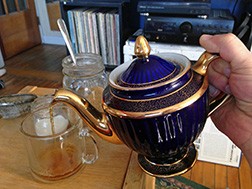Let Loose: A guide to loose leaf tea
- Share
- Tweet
- Pin
- Share

Although your cup of Joe may get you going in the morning, there is one beverage that is far more widely consumed for its caffeine and antioxidant properties: tea.
The health benefits of tea are widely known, with its antioxidants being credited with protecting the body from cancer and reducing the risk of heart attacks and other diseases. It is also relatively simple to make and comes down to one consideration: bagged or loose leaf?
For most loose tea lovers, like Karen McCarthy (co-owner of Tea Thyme in Sister Bay), it comes down to quality and flavor.
“[Bagged tea] is tea from further down the process,” McCarthy said. “They take out the highest quality teas first to be the loose leaf and then the tea in the tea bags is towards the end of the process.”
It may sound intimidating to get into, but at its basic level, making the perfect up of loose leaf tea comes down to three things: the tea leaf, water and steep.
Although there are thousands of kinds of tea, there are four major categories that encompass “true tea” (which come from the same plant, the Camellia sinensis): white, green, oolong and black, which speak to how much a tea is oxidized (the natural process that changes the color and flavor of tea leaves). Herbal teas are those that come from other leaves, roots, fruits or flowers.
“Herbal teas are not actually teas as such because they’re not made from the tea plant, so they’re called tisanes because there is no tea in them,” McCarthy said. “It’s just herbs and flowers and spices.”
There are several ways to steep loose leaf tea: directly in the teapot (after steeping, use a tea strainer to prevent loose leaf tea from getting into cup), a tea infuser ball, or in a teapot or cup with a built-in infuser. Whichever option you choose, keep in mind that tea leaves need room to expand in order to release their full flavor. McCarthy prefers the use of a tea strainer, which allows the flavors to mix well.
The type of tea one brews influences the water temperature and steep time, with a general breakdown as follows: white and green tea, 175-degree water, steep for two to three minutes; oolong tea, 205-degree water, steep for 4 – 5 minutes; and black or herbal tea, 212-degree water, steep for 4 – 5 minutes.
Water temperature is easiest to determine for black and herbal tea – simply bring the water to a boil, which happens at 212 degrees Fahrenheit. For the others, McCarthy suggests bringing water to a boil, transferring it to another container, then using a thermometer to monitor the temperature while it lowers to the appropriate number.
The steep time is equally as important as the temperature, as it impacts the flavor.
“It’s the temperatures that the flavors of the tea are released,” McCarthy said. “Whites and green leaves are more delicate. They haven’t been processed as much so the flavor is released earlier at a lower temperature whereas with the black and the herbal teas, it’s the hotter water that brings out the flavor.”
To brew the perfect cup, McCarthy recommends heating filtered, spring or bottled water on a stovetop to boiling, then pouring a small amount of water into a teapot and swirling it around to warm the pot. Discard the water. Place the loose leaf tea into the teapot using 1 teaspoon of tea per cup of water, then when the water is lowered to the appropriate temperature, pour the water into the teapot and let steep for the designated amount of time. McCarthy typically covers the teapot with a tea cozy, then pours the tea through a strainer into a cup.
Loose leaf tea may be steeped more than once, although subsequent uses of the same tea will lessen the amount of caffeine and flavor in it. When McCarthy is finished with her tea, she repurposes the used tea leaves by putting them on top of her plant soil, which keeps the soil moist.
For those interested in visual and taste bud stimulation, look no further than blooming teas. Blooming teas are artisan teas where handpicked tea leaves are wrapped around flowers to form small rosettes. After hot water is added, the flowers bloom as they seep.
As for storage, loose leaf tea begins to lose some of its quality after six months, McCarthy said, though it may last up to two years if kept in a dark, dry place. For fruit teas and teas with flowers, 12 months seems to be the limit.
For those who prefer the convenience of bagged tea with the flavor potential of loose leaf, McCarthy recommends purchasing make-your-own tea bags and filling them with loose leaf tea.
When it comes down to it, personal preference prevails.
“Certainly there is nothing wrong with bagged tea,” McCarthy said. “It’s more convenient and everybody has a different taste. You can certainly get a good cup of tea from a tea bag but sometimes there is more of a ceremony to making a cup of tea with loose leaf.”
